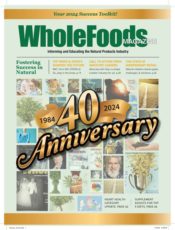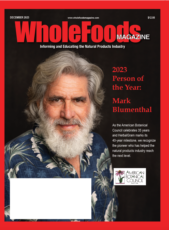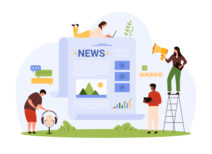
WholeFoods Magazine
QR Codes and Why You Should Care

You may have started seeing these new square codes being placed in magazines ads, on billboards and packaging. Major national brands are starting to take notice, marketing departments are beginning to wake up, and the early adopters of smart phones and mobile applications have been using them for a while now. These little black-and-white boxes aren’t just little weird stamps. They are the next buzz word for marketing, and the next wave in scan technology.
QR is short for “quick response”, and these codes are specific matrix barcodes that are reada ble by dedicated QR barcode readers and camera phones. The information encoded can be text, a URL, images or other data. QR codes were first introduced in 1994 by a Japanese corporation, and were originally designed as a new way to track automotive parts. While there are a number of 2-D scanning codes in use (UPC, Datamatrix, Maxicode, and even color barcodes), most of them have limited capabilities (93 to several thousand bits of information stored) compared to QR codes which can store over 4,000 alphanumeric or over 7000 numeric characters.
ble by dedicated QR barcode readers and camera phones. The information encoded can be text, a URL, images or other data. QR codes were first introduced in 1994 by a Japanese corporation, and were originally designed as a new way to track automotive parts. While there are a number of 2-D scanning codes in use (UPC, Datamatrix, Maxicode, and even color barcodes), most of them have limited capabilities (93 to several thousand bits of information stored) compared to QR codes which can store over 4,000 alphanumeric or over 7000 numeric characters.
Just a few of the applications we’re seeing for QR codes are in magazines, on signs, business cards, t-shirts, tattoos, and for everything from steering customers to a website or tracking inventory, to marketing videos, and capturing coupons. But, then there’s also the barista reading a customer’s QR code information off of her smart phone to make sure she gets her favorite sugar free, no fat, hazelnut, decaf coffe with a dash of chocolate and has it automatically taken from her debit card. Have I got your attention yet? We’re not even scratching the surface of what’s to come. The fact that both Google and Blackberry have chosen the QR code as a standard should cause suppliers and retailers alike to sit up, take notice and consider the possibilities these codes may have for marketing their business and brand.
QR codes aim to make our lives increasingly fulfilling, efficient and allow us to move between physical and digital worlds while being educated and informed along the way. We can expect QR codes to dramatically impact the future of print, television, and various media by adding interactivity. You can now easily lead your customer from your offline marketing piece to your richer online content. The codes also will drastically reduce paper waste, for instance allowing paperless air travel and ticketing for all sorts of venues. The possibilities seem endless.
Many new technologies are quickly surpassed by new innovations in the blink of an eye in the 21st century. However, QR codes appear to have set a standard which could last quite a while and be one of the more transformational scan code applications in modern history. If you’d like to know more, stick around. In future blogs, we’ll not only get you started with QR codes, we’ll begin to explore some of the most important tips you need to understand in order to best use and apply QR codes for your business.
 Geoffrey Robinson is founder of Digital Earth Network, a leader in the emerging world of mobile and digital marketing content and associated applications. Geoffrey was the former founder of Eye Force Productions, a web based advertising company, and has an extensive professional background, particularly in the Natural Foods industry, in sales, marketing, business operations, consulting, Point of Sale technology and other related verticals.
Geoffrey Robinson is founder of Digital Earth Network, a leader in the emerging world of mobile and digital marketing content and associated applications. Geoffrey was the former founder of Eye Force Productions, a web based advertising company, and has an extensive professional background, particularly in the Natural Foods industry, in sales, marketing, business operations, consulting, Point of Sale technology and other related verticals.
Posted on WholeFoods Magazine Online, April 13, 2011







